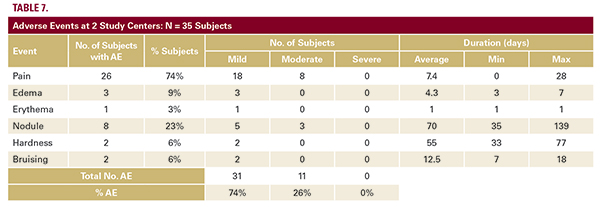
 at the hyperthermic temperature range 42°C to 47°C to cause adipocyte injury and induce inflammatory response to remove damaged adipocytes over the ensuing months.5 Optimal treatment time was between 20-25 minutes. Treatment times longer than 30 minutes were associated with a risk of developing palpable nodules in subcutaneous fat. Treatment times less than 20 minutes had minimal effect.4Radiation at 1060 nm wavelength heats the fat layer with controlled temperature elevation, distributing the heating more evenly over a broad zone conspired to higher wavelengths.16,17 Studies of hyperthermia induced tissue damage and ex vivo temperature measurements have shown that hyperthermic temperature can be achieved and maintained in subcutaneous adipose tissue by a 1060 nm laser in conjunction with surface cooling.14-16 The 1060 nm optical energy does not have a specific chromophore in the skin and therefore generates non-specific heating.Other treatments that depend on heat destruction of adipose tissue are ultrasound18 and radiofrequency.4 With high intensity focused ultrasound (HIFU) the temperature quickly reaches 56°C, and has been reported to rapidly raise tissue temperature over 70°C,19 which is effective in coagulative necrosis of the adipocytes and subsequent reduction of the fat layer. Therefore, HIFU has the potential to cause nonselective instantaneous cell necrosis at the designated target.19,20 Radiofrequency technology utilizes the resistance (impedance) of the tissue itself to generate heat rather than directly transferring heat. Because adipocytes have high tissue resistance and low heat transfer coefficients, they generate significant heat when radiofrequency energy is passed through the tissue and at the same time limiting the spread of this heat to surrounding structures.21 Another treatment, cryolipolysis, depends on cold-induced adipocyte apoptosis. This treatment is based upon the greater susceptibility of lipid-rich adipocytes to cold injury compared to surrounding water rich cells. The phenomenon was established in a study on pigs that showed damage to subcutaneous fat without damage to the overlying skin.9,22 A prior study compared cryolipolysis to the 1060 nm diode laser for fat reduction. Based on ultrasound, MRI, and photographic evaluations the use of the 1060 nm laser treatment gives comparable results to cryolipolysis.5Empirical results with patient discomfort score correlate with the target temperatures of the treatment. Most patients will perceive temperatures in the low 40 C range to be warm but
at the hyperthermic temperature range 42°C to 47°C to cause adipocyte injury and induce inflammatory response to remove damaged adipocytes over the ensuing months.5 Optimal treatment time was between 20-25 minutes. Treatment times longer than 30 minutes were associated with a risk of developing palpable nodules in subcutaneous fat. Treatment times less than 20 minutes had minimal effect.4Radiation at 1060 nm wavelength heats the fat layer with controlled temperature elevation, distributing the heating more evenly over a broad zone conspired to higher wavelengths.16,17 Studies of hyperthermia induced tissue damage and ex vivo temperature measurements have shown that hyperthermic temperature can be achieved and maintained in subcutaneous adipose tissue by a 1060 nm laser in conjunction with surface cooling.14-16 The 1060 nm optical energy does not have a specific chromophore in the skin and therefore generates non-specific heating.Other treatments that depend on heat destruction of adipose tissue are ultrasound18 and radiofrequency.4 With high intensity focused ultrasound (HIFU) the temperature quickly reaches 56°C, and has been reported to rapidly raise tissue temperature over 70°C,19 which is effective in coagulative necrosis of the adipocytes and subsequent reduction of the fat layer. Therefore, HIFU has the potential to cause nonselective instantaneous cell necrosis at the designated target.19,20 Radiofrequency technology utilizes the resistance (impedance) of the tissue itself to generate heat rather than directly transferring heat. Because adipocytes have high tissue resistance and low heat transfer coefficients, they generate significant heat when radiofrequency energy is passed through the tissue and at the same time limiting the spread of this heat to surrounding structures.21 Another treatment, cryolipolysis, depends on cold-induced adipocyte apoptosis. This treatment is based upon the greater susceptibility of lipid-rich adipocytes to cold injury compared to surrounding water rich cells. The phenomenon was established in a study on pigs that showed damage to subcutaneous fat without damage to the overlying skin.9,22 A prior study compared cryolipolysis to the 1060 nm diode laser for fat reduction. Based on ultrasound, MRI, and photographic evaluations the use of the 1060 nm laser treatment gives comparable results to cryolipolysis.5Empirical results with patient discomfort score correlate with the target temperatures of the treatment. Most patients will perceive temperatures in the low 40 C range to be warm but






